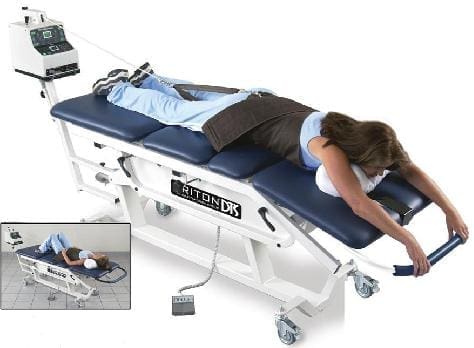Table of Contents
Introduction
In the lower half region of the body, a large nerve connects to the lumbar region of the spine that travels down to the legs. This is the sciatic nerve, and its primary function is to provide mobility to the legs. The legs use the sciatic nerve to move, feel, and stabilize the body as it is in motion. When the lumbar region of the spine begins to natural wear and tear from injuries or ordinary factors like lifting heavy objects can cause the spinal discs in the spine to herniate and press on the sciatic nerve. When this happens, the sciatic nerve sends out pain signals that travel down the legs and back to the brain, causing symptoms like sciatica to develop. Luckily some therapies can help prevent sciatica from developing further and provide relief to many suffering individuals. Today’s article focuses on the factors that cause sciatica and how treatments like decompression therapy can help prevent sciatica-like factors from progressing further for many individuals. Referring patients to qualified and skilled providers who specialize in spinal decompression therapy. We guide our patients by referring to our associated medical providers based on their examination when it’s appropriate. We find that education is essential for asking insightful questions to our providers. Dr. Alex Jimenez DC provides this information as an educational service only. Disclaimer
Can my insurance cover it? Yes, it may. If you are uncertain, here is the link to all the insurance providers we cover. If you have any questions or concerns, please call Dr. Jimenez at 915-850-0900.
What Is Sciatica?
Do you feel pain running down your legs? Does it hurt when you are walking, even for a short distance? How about muscle stiffness that is occurring in your lower back and legs? All these symptoms are signs that you are experiencing sciatica. Research studies have defined sciatica as a throbbing, sharp pain that affects one side of the body and travels down each leg. Whenever a person is suffering from sciatica, the pain symptoms usually vary, depending on how severe it affects the legs. Sciatica usually forms when the spine suffers from a herniated disc, or the piriformis muscle starts to compress on the sciatic nerve, causing it to become irritated. Additional information shows that various conditions that can structurally impact or even compress the sciatic nerve can result in sciatica symptoms that can hinder a person’s ability to walk. Injuries to the spine are not the only factors that can cause sciatica to occur, as ordinary factors can also be an issue.
Factors That Cause Sciatica
Now many factors can cause sciatica to develop. Some of these factors can be ordinary everyday habits that many have adopted that don’t realize are causing sciatica pain. Research studies have shown that many individuals that are suffering from low back pain from strenuous working conditions like sitting down in a desk job for long periods can cause an increased risk of developing sciatica. Sitting for an extended period can cause a person to create poor posture, which leads to low back pain and thus developing sciatica. Another factor that can lead to sciatica is lifting heavy objects. Additional research studies have shown that when workers handle carrying or lifting heavy objects can affect their lower back. The heavyweight of the object causes stress and tension on the lower muscles causing the individual to ache in pain. These painful symptoms can cause the lower muscles to compress and aggravate the sciatic nerve. Luckily some treatments can help prevent these factors from irritating the sciatic nerve and prevent sciatica from progressing.
Things To Avoid With Sciatica-Video
Are you feeling muscle strain from lifting or carrying heavy objects? Does your lower back ache after an extended period of sitting down? Do you feel aggravating pain in the back of your legs? You could be suffering from sciatica, and decompression therapy might be able to help. The video above explains the ten things to avoid when dealing with sciatica. Decompression therapy allows the individual experiencing sciatica to feel relief in their lower back. It uses gentle traction on the spine to enable the aggravated sciatic nerve to relax while also loosening up the stiff muscles that are causing immobility to the lower back. Incorporating decompression therapy as a wellness treatment is beneficial. This link will explain how decompression offers optimal comfort for many people who suffer from sciatica while also returning them to their health and wellness journey.
How Decompression Can Alleviate Sciatica Factors
Many treatments are available to help with sciatica symptoms and low back pain symptoms that can relieve the suffering individual. Research studies have shown that decompression treatments for sciatica can be delivered to many individuals by reducing the pain that the piriformis muscle has trapped. When the piriformis muscle is gently moved away from the sciatic nerve, the pain signals will lessen from sending information to the brain. Other research studies have shown that decompression treatments for trapped sciatic nerves will provide pain reduction to the leg muscles and relieve the buttock muscles from suffering from muscle spasms. Many individuals that suffer from sciatica will also feel relief from the negative pressure that decompression treatment has provided.
Conclusion
Overall, sciatica can be caused by factors that can be ordinary, like sitting for an extended period, lifting, or carrying heavy objects. Other factors can be simple as a herniated disc or piriformis syndrome. Decompression treatments allow the individual to feel instant relief from sciatica by gently stretching the spine to alleviate the pressure off of the sciatic nerve. Once the sciatic nerve starts to feel better after being aggravated, the lower half of the body will begin to relax, and the individual will become pain-free.
References
Davis, David, et al. “Sciatica – Statpearls – NCBI Bookshelf.” In: StatPearls [Internet]. Treasure Island (FL), StatPearls Publishing, 6 May 2022, https://www.ncbi.nlm.nih.gov/books/NBK507908/.
Euro, Ulla, et al. “Work-Related Risk Factors for Sciatica Leading to Hospitalization.” Scientific Reports, Nature Publishing Group UK, 25 Apr. 2019, https://www.ncbi.nlm.nih.gov/pmc/articles/PMC6484005/.
Hogan, Elizabeth, et al. “A Minimally Invasive Surgical Approach for the Treatment of Piriformis Syndrome: A Case Series.” Chinese Neurosurgical Journal, BioMed Central, 30 Mar. 2020, https://www.ncbi.nlm.nih.gov/pmc/articles/PMC7398220/.
Lis, Angela Maria, et al. “Association between Sitting and Occupational LBP.” European Spine Journal : Official Publication of the European Spine Society, the European Spinal Deformity Society, and the European Section of the Cervical Spine Research Society, Springer-Verlag, Feb. 2007, https://www.ncbi.nlm.nih.gov/pmc/articles/PMC2200681/.
Park, Myung-Sik, et al. “Clinical Results of Endoscopic Sciatic Nerve Decompression for Deep Gluteal Syndrome: Mean 2-Year Follow-Up.” BMC Musculoskeletal Disorders, BioMed Central, 20 May 2016, https://www.ncbi.nlm.nih.gov/pmc/articles/PMC4875686/.
Staff, Mayo Clinic. “Sciatica.” Mayo Clinic, Mayo Foundation for Medical Education and Research, 1 Aug. 2020, https://www.mayoclinic.org/diseases-conditions/sciatica/symptoms-causes/syc-20377435.
Disclaimer
Post Disclaimer
Professional Scope of Practice *
The information on this blog site is not intended to replace a one-on-one relationship with a qualified healthcare professional or licensed physician and is not medical advice. We encourage you to make healthcare decisions based on your research and partnership with a qualified healthcare professional.
Blog Information & Scope Discussions
Welcome to El Paso's Premier Wellness and Injury Care Clinic & Wellness Blog, where Dr. Alex Jimenez, DC, FNP-C, a board-certified Family Practice Nurse Practitioner (FNP-BC) and Chiropractor (DC), presents insights on how our team is dedicated to holistic healing and personalized care. Our practice aligns with evidence-based treatment protocols inspired by integrative medicine principles, similar to those found on this site and our family practice-based chiromed.com site, focusing on restoring health naturally for patients of all ages.
Our areas of chiropractic practice include Wellness & Nutrition, Chronic Pain, Personal Injury, Auto Accident Care, Work Injuries, Back Injury, Low Back Pain, Neck Pain, Migraine Headaches, Sports Injuries, Severe Sciatica, Scoliosis, Complex Herniated Discs, Fibromyalgia, Chronic Pain, Complex Injuries, Stress Management, Functional Medicine Treatments, and in-scope care protocols.
Our information scope is limited to chiropractic, musculoskeletal, physical medicine, wellness, contributing etiological viscerosomatic disturbances within clinical presentations, associated somato-visceral reflex clinical dynamics, subluxation complexes, sensitive health issues, and functional medicine articles, topics, and discussions.
We provide and present clinical collaboration with specialists from various disciplines. Each specialist is governed by their professional scope of practice and their jurisdiction of licensure. We use functional health & wellness protocols to treat and support care for the injuries or disorders of the musculoskeletal system.
Our videos, posts, topics, subjects, and insights cover clinical matters and issues that relate to and directly or indirectly support our clinical scope of practice.*
Our office has made a reasonable effort to provide supportive citations and has identified relevant research studies that support our posts. We provide copies of supporting research studies available to regulatory boards and the public upon request.
We understand that we cover matters that require an additional explanation of how they may assist in a particular care plan or treatment protocol; therefore, to discuss the subject matter above further, please feel free to ask Dr. Alex Jimenez, DC, APRN, FNP-BC, or contact us at 915-850-0900.
We are here to help you and your family.
Blessings
Dr. Alex Jimenez DC, MSACP, APRN, FNP-BC*, CCST, IFMCP, CFMP, ATN
email: coach@elpasofunctionalmedicine.com
Licensed as a Doctor of Chiropractic (DC) in Texas & New Mexico*
Texas DC License # TX5807
New Mexico DC License # NM-DC2182
Licensed as a Registered Nurse (RN*) in Texas & Multistate
Texas RN License # 1191402
ANCC FNP-BC: Board Certified Nurse Practitioner*
Compact Status: Multi-State License: Authorized to Practice in 40 States*
Graduate with Honors: ICHS: MSN-FNP (Family Nurse Practitioner Program)
Degree Granted. Master's in Family Practice MSN Diploma (Cum Laude)
Dr. Alex Jimenez, DC, APRN, FNP-BC*, CFMP, IFMCP, ATN, CCST
My Digital Business Card




